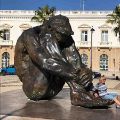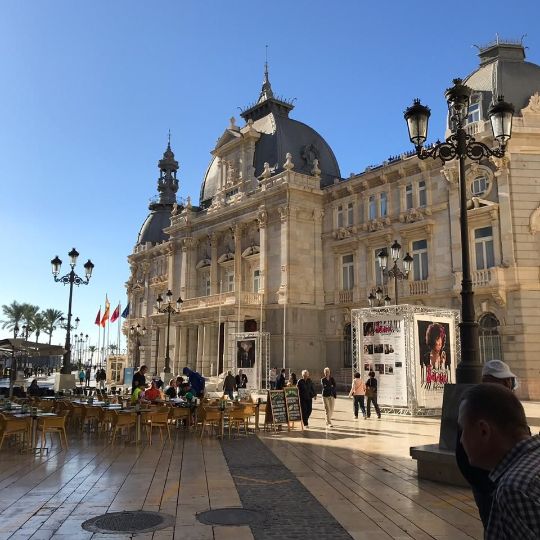
EL ZULO
The bronze monument of El Zulo in Cartagena, it is a work of the Spanish sculptor Victor Ochoa. The total cost of the sculpture: $750,000. Almost a million of Euro can be seen on Alfonso Street
Additionaly, Cartagena is located on the Mediterranean coast, so travelers can also spend time relaxing on the beach or exploring the bays for historical artifacts :)
Interesting facts:
Cartagena is a Spanish city was founded in 227 BC (also know as New Carthage). This strategic location surrounded by mountains and with access to the sea.
Cartagena was an important naval base during the Roman Empire and served as a major trading hub for the Mediterranean. Today, this port is considered the key in the country, and its name speaks for itself Puerto Commercial.
Cartagena is famous for the large number of archaeological sites in the region. Fact: the main attraction of the city - the Roman Theatre was discovered only in 1988.
By car. The first assumes the presence of own car. The distance from Alicante to Cartagena: 130 km. So, we have two autobahns available. The AP-7 toll highway and the N-332 regular highway, along the coast. Travel time: 1 hour. From the coastal resort as Orihuela Costa or Torrevieja to Cartagena follow the same directions as from Alicante.
By taxi: The second is the old and proven method is a "calling " a taxi to Cartagena:
From Alicante - 80 $ - Torrevieja - 38 $ - La Zenia - 33 $ - Orihuela Costa - 35 $ - Murcia - 44 $ - or book a car with personal driver <<-
The third option for getting to Cartagena is to use public transport. The train journey Alicante - Cartagena does not last more than 2h.30 min, and from the Murcia - 1 h. Yes, you can get from Torrevieja to Cartagena by bus with the Alicante – Cartagena line with ALSA.
Cartagena is easy to visit if you only have one day since it is a compact city with just a few big sites. Here's how to see the best of Cartagena in a day:

Cartagena City Hall
As one walks throught the neighborhoods, the attention is immediately drawn to the numerous archaeological works. The reasons for this abundance is the presence of the Roman Theatre. It was discovered in the 1980s. In this story, amazing is the fact that a monument of such magnitude was hiding from the gaze of passers-by, literally under the nose. Draw the formula: take the date of laying the first city stone with the period of discovery, take into account the size of the center: 1x1 kilometers. WOW!
The Roman Theatre in Cartagena is a well-preserved ancient structure that dates back to the 1st century.
The theater was buil during the reign of Emperor Augustus and was used for various events, inclunding theatrical perfomances and gladiator fights. It could accommodate up to 6.000 spectators and was a significant cultural center during the Roman Empire.
Today, visitors can explore the theater. The stage, seating areas, and underground chambers are all open to the public, providing a unique glimpse to the past.
The Roman Theater is located in the heart of Cartagena's historic district and is surrounded by other ancient ruins. It is a must-see attraction for anyone interested in Roman architecture.
With so much to see and do, Cartagena is must-visit destination in Spain. From the Amphitheatre to the fortress of Galeras there is something for everyone to enjoy. However, it's important to take a moment to appreciate the city itself. In addition to the typical tourist hotspots, Cartagena boasts unique and worthwhile attractions. Here are some recommendations:
No one day in Cartagena itinerary could hope to cover everything there is to see in the city– but if you have more time in Cartagena, consider paying a visit to Calblanque Park, go hiking in the Sierra de la Muela, or simply wander the closest beaches and soak up the views.
Football is a popular sport in Cartagena, with many local teams. The most prominent club in the city is FC Cartagena, which was founded in 1995 and currently plays in Segunda Division, the second tier of Spanish football. The club's home ground is the Estadio Municipal Cartagonova.
This festival takes place in July and features a diverse lineup of international artists perfoming a wide variety of genres, including world music, jazz & pop. Learn More >>
This festival takes place in September and commemorates the city's Roman and Carthaginian past. The festival includes reenactments of historical battles, parades, and other cultural events. Read more >>
Celebrated in March or April, Holy Week is one of the most important festivals in Cartagena. The city is known for its elaborate processions, which feature religious statues that are carried throught the streets by members of local brotherhoods.
© 2023 La Zenia Info. All rights reserved.